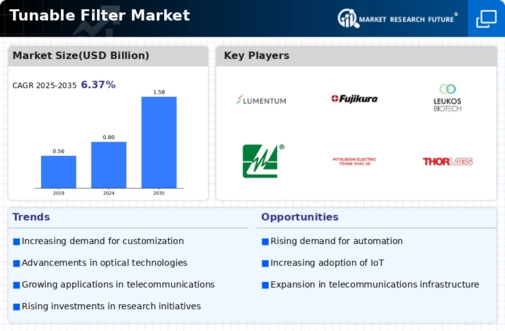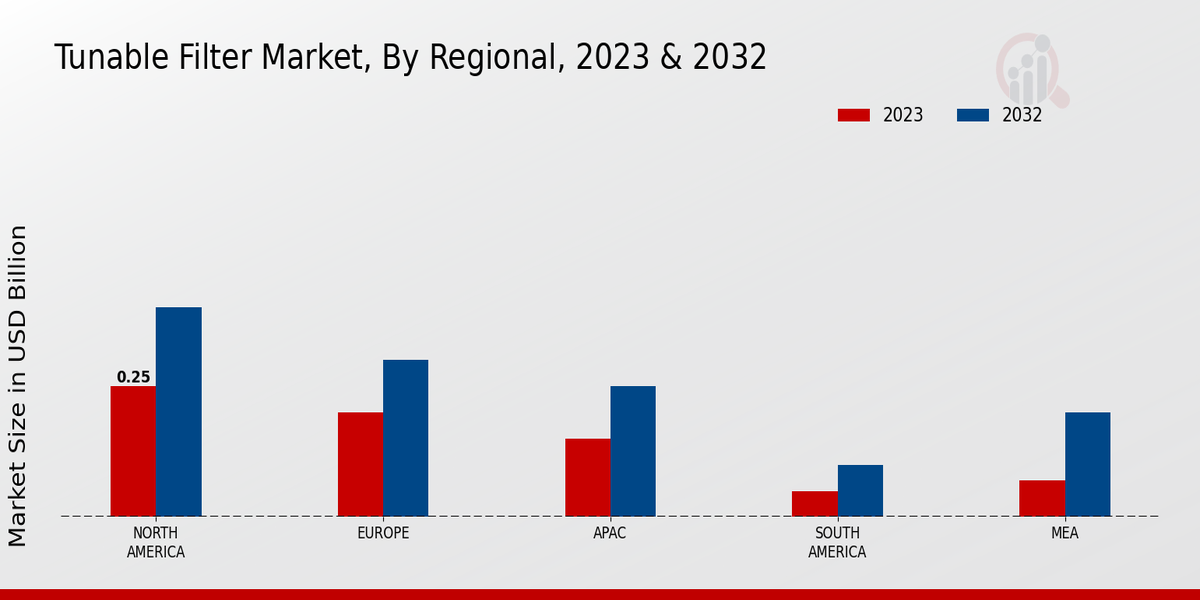Market Growth Projections
The Global Tunable Filter Market Industry is projected to experience substantial growth over the coming years. With an estimated market value of 0.8 USD Billion in 2024, the industry is on a trajectory to reach 1.58 USD Billion by 2035. This growth is indicative of the increasing reliance on tunable filters across various applications, including telecommunications, optical networks, and sensing technologies. The compound annual growth rate of 6.41% from 2025 to 2035 further emphasizes the market's potential as industries continue to adopt advanced filtering solutions to meet their evolving needs.
Rising Adoption in Optical Networks
The Global Tunable Filter Market Industry is significantly influenced by the rising adoption of tunable filters in optical networks. These filters play a crucial role in wavelength division multiplexing (WDM) systems, enabling the efficient transmission of multiple signals over a single optical fiber. As the demand for high-speed internet and data services escalates, the need for sophisticated optical components, including tunable filters, becomes increasingly critical. The market's growth trajectory suggests a potential increase to 1.58 USD Billion by 2035, driven by advancements in optical technologies and the expansion of fiber optic infrastructure globally.
Technological Advancements in Filter Design
Technological advancements in filter design are propelling the Global Tunable Filter Market Industry forward. Innovations such as micro-electromechanical systems (MEMS) and liquid crystal tunable filters are enhancing the performance and versatility of tunable filters. These advancements allow for greater precision in frequency selection and improved signal integrity, which are essential for modern communication systems. As industries seek to optimize their operations and improve efficiency, the adoption of these advanced filters is likely to increase. The projected compound annual growth rate of 6.41% from 2025 to 2035 indicates a robust market response to these technological developments.
Emerging Applications in Sensing Technologies
The Global Tunable Filter Market Industry is witnessing growth due to emerging applications in sensing technologies. Tunable filters are increasingly utilized in environmental monitoring, biomedical applications, and industrial sensing, where precise wavelength selection is essential. These applications benefit from the adaptability and precision of tunable filters, allowing for enhanced data collection and analysis. As industries recognize the value of accurate sensing solutions, the demand for tunable filters is expected to rise. This trend indicates a broader acceptance of tunable filters across diverse sectors, further solidifying their role in advancing technology and improving operational efficiency.
Growing Demand for Advanced Communication Systems
The Global Tunable Filter Market Industry experiences a surge in demand driven by the increasing need for advanced communication systems. As telecommunications evolve, the necessity for high-performance filters that can adapt to varying frequencies becomes paramount. This trend is particularly evident in the deployment of 5G networks, which require tunable filters to manage the complex spectrum efficiently. The market is projected to reach 0.8 USD Billion in 2024, reflecting the industry's response to these technological advancements. Furthermore, the anticipated growth in mobile data traffic underscores the importance of tunable filters in ensuring seamless connectivity and high-quality communication.
Increasing Investment in Research and Development
Investment in research and development is a key driver of the Global Tunable Filter Market Industry. As companies strive to innovate and enhance their product offerings, substantial resources are allocated to R&D initiatives. This focus on developing next-generation tunable filters that meet the evolving needs of various applications, including telecommunications and spectroscopy, is crucial. Government funding and private sector investments are fostering an environment conducive to innovation. The anticipated growth in the market reflects the positive impact of these investments, as they enable the introduction of more efficient and effective filtering solutions.










